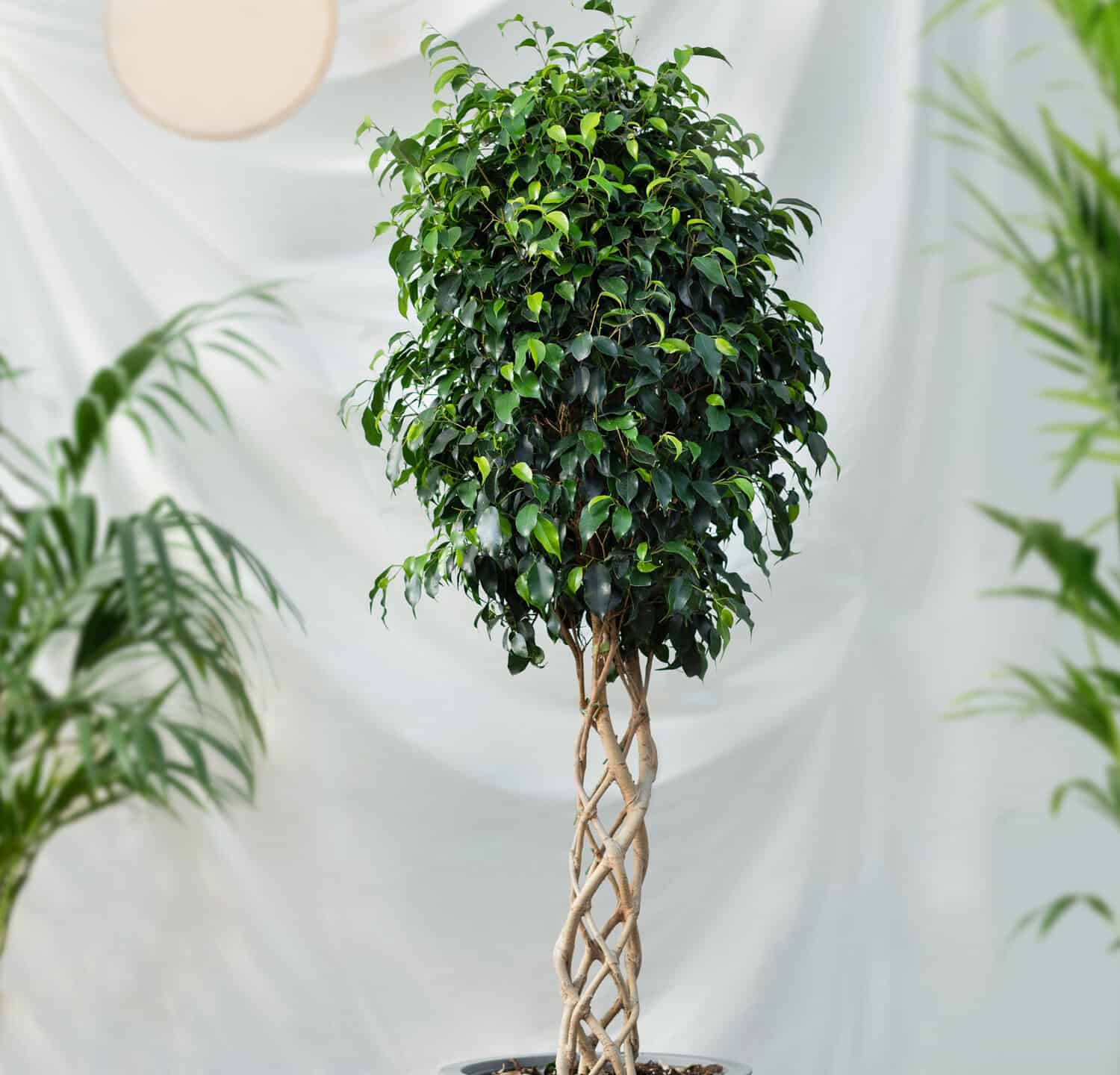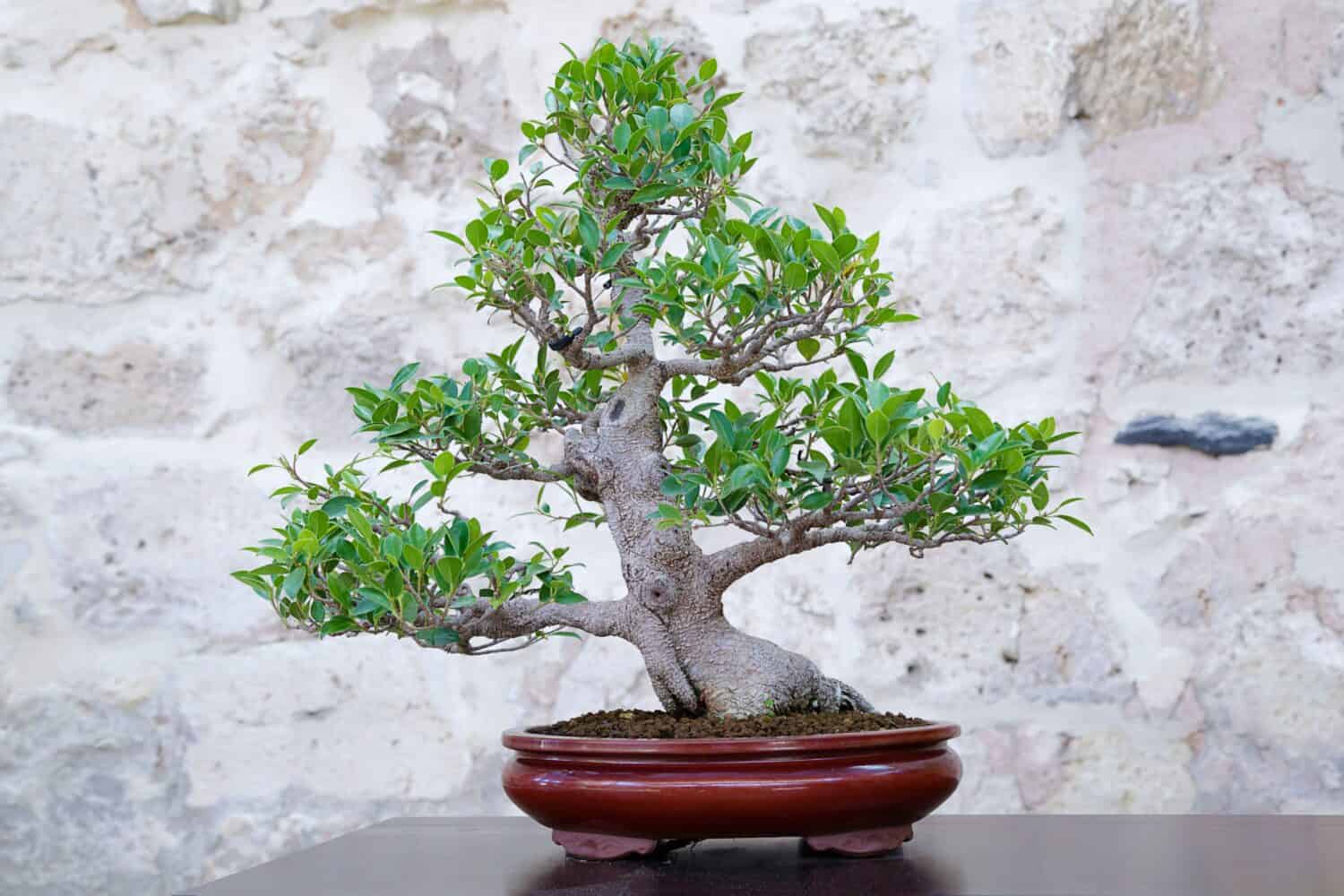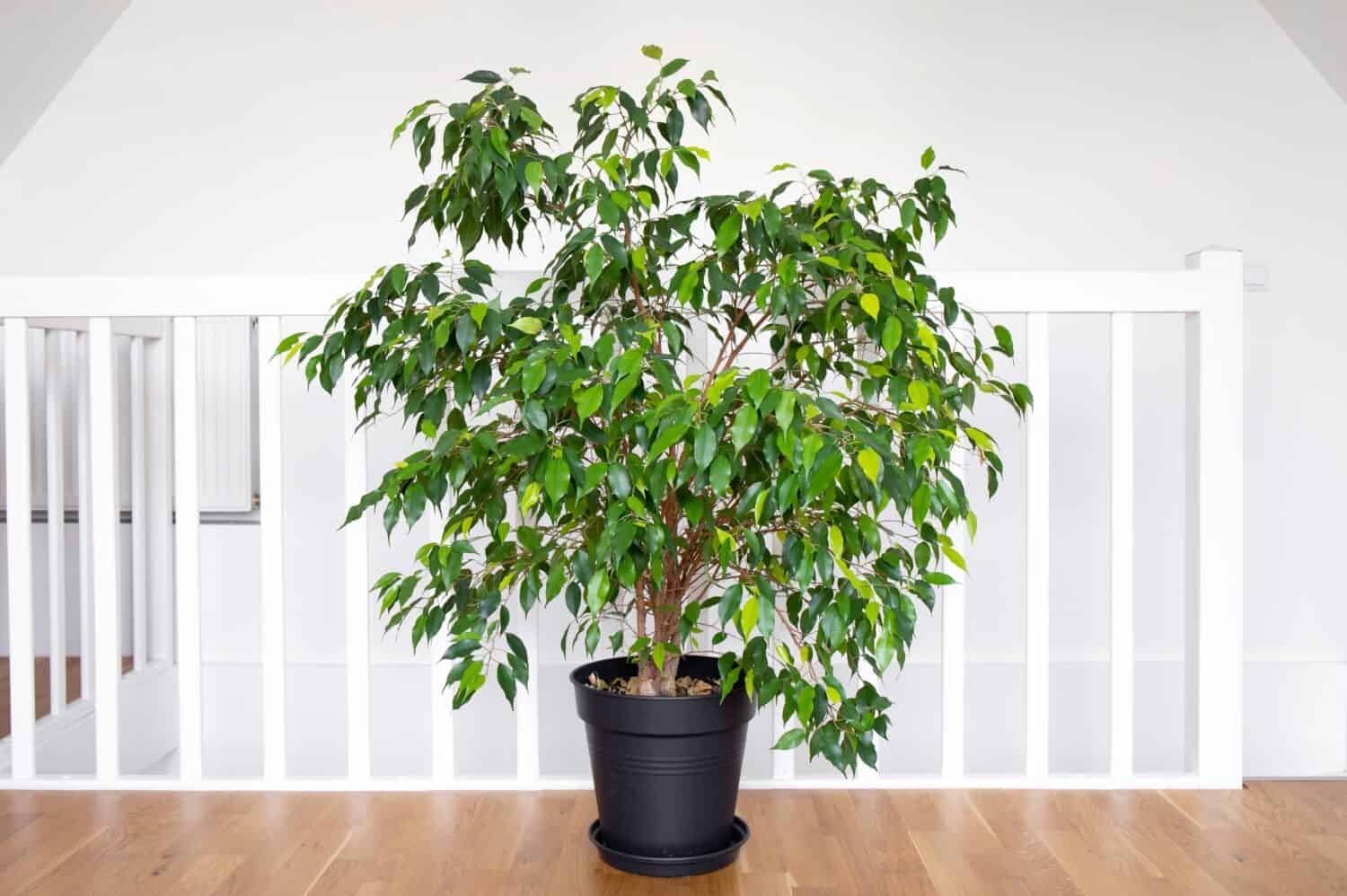| Scientific Name | Ficus benjamina |
| Common Names | Indian Rubberplant, Weeping Fig, Benjamin Tree |
| Region | Asia, Australia, southwest Pacific |
| Size | 40 to 50 feet tall and 20 to 30 feet wide |
| Sunlight | Direct sunlight to partial shade |
| Safety Notes | Weeping fig bonsai trees contribute significantly to indoor allergen levels. Those with environmental allergens may want to avoid keeping one indoors. Additionally, there is latex in the leaves and extreme caution should get used around those with latex allergies. |
Bonsai trees have long been revered for their beauty and artistic appeal. Gardeners, plant lovers, and bonsai enthusiasts all flock to the plant for its easy nature and moldability. There are many captivating varieties, making it easy to find one that suits your particular aesthetic. But one, in particular, stands out for its graceful cascading branches and glossy foliage. The weeping fig bonsai tree (Ficus benjamina) is an extremely popular choice among bonsai enthusiasts. Below, we will cover everything you need to know to select and care for a weeping fig bonsai tree.
Common Types of Weeping Fig Bonsai Tree
Weeping fig bonsai trees belong to the Moraceae (fig) family. The beloved species has six different cultivars. So it is easy to find the best fit for your home, taste, and pruning preference.
- ‘Danielle’
- ‘Exotica’
- ‘Golden King’
- ‘Naomi’
- ‘Too Little’
- ‘Variegata’

Weeping figs make fantastic bonsai trees. You can mold them in nearly any way you wish.
©Farhad Ibrahimzade/Shutterstock.com
Caring for Your Weeping Fig Bonsai Tree
Ensure the health and vitality of your weeping fig bonsai tree with the proper care and attention it deserves. Here are some factors to consider:
Sunlight
Weeping fig bonsais love sunny areas. Placing your bonsai near a window that receives ample sunlight during the day is ideal. However, it is not the end of the world if you don’t have a location that receives plenty of light. This tree will do fine in partially shaded areas.
Soil Type
Select a loose, well-draining, soil-based potting mix for your weeping fig bonsai. It doesn’t necessarily need a special blend. So whatever you can find at your local garden center or nursery should suffice.
Water
These lovely trees require a moderate amount of watering. Not too much and not too little. Avoid allowing the soil to dry out too much during the summer. Sticking your finger down roughly two inches into the soil will help you determine when to water. If it is still moist, you can wait a while longer.
During the winter, your weeping fig bonsai will not require as much water.
Placement
Keep your tree away from drafts or extreme temperature fluctuations. It does not like to get cold or experience drastic shifts in temperature. Weeping fig bonsais prefer a stable environment, ideally with temperatures ranging between 65°F and 75°F (18°C to 24°C). Avoid placing your bonsai near heating or cooling vents, as these can create sudden temperature changes that may stress the tree.
Pruning Your Weeping Fig Bonsai Tree
One of the best parts about owning a bonsai tree is that you can sculpt it however you want! They are a very moldable species, making them effectively a living work of art. Feel free to experiment and try new things. But before you do – it helps to understand some of the pruning basics so your tree does not get damaged.
Branch Pruning
Trim back long branches that disrupt the overall balance and aesthetics of the tree. Use sharp bonsai pruning shears to make clean cuts at a 45-degree angle. This step will promote healthy growth and maintain the desired shape of your bonsai tree.
Leaf Pruning
Remove excess foliage through leaf pruning. Doing so will help enhance airflow and allow light to reach the inner branches. Pinch or prune leaves to maintain the desired shape and density. This process will ensure that the tree receives adequate light and air circulation.
Recommended Weeping Fig Bonsai Tree Styles
The weeping fig bonsai tree lends itself well to various bonsai styles. If you are new to bonsai care, consider selecting one of these tried-and-true pruning styles.
Cascade Style
This style emphasizes the cascading nature of the tree’s branches. It creates a visually striking and flowing appearance. Cascading your bonsai includes carefully training the branches to cascade downward, creating a waterfall-like effect. It requires using wires and gentle bending to achieve the aesthetic you envision.
Informal Upright Style
This style features a slightly curved trunk. Prune the tree to create a tapered, “S” shaped pattern. Allow the leaves to grow at each bend.
Multi-Trunk Style
This style is more difficult to achieve but produces a mini-forest effect. It showcases multiple trunks growing out of one root. The leaves get pruned at the top of each branch to replicate the canopies you might see in a forest.

Some bonsai styles are beginner-friendly. But others take a slightly more advanced touch.
©Raquel Pedrosa/Shutterstock.com
Propagating Your Weeping Fig Bonsai Tree
If you wish to expand your bonsai collection or share the joy of bonsai with others, consider propagating your weeping fig bonsai. It is a simple and beginner-friendly process.
Air Layering
Select a healthy branch and make an incision. Then wrap the cut section with rooting hormone or moist sphagnum moss. Enclose the moss with plastic wrap to create a moist environment. After the roots have developed, you can separate the branch from the parent tree and plant it in a new pot. This method requires some patience, as it may take up to a year for the new root system to grow.
Cuttings
Take 4- to 6-inch cuttings from new growth. Each cutting should have at least two sets of leaves. Dip the cut end in rooting hormone and plant it in a well-draining potting mix. Provide consistent moisture and warmth for new roots to develop. Using this method, you will only need to wait a few weeks for your new bonsai tree to develop a healthy root system.
Common Problems with Weeping Fig Bonsai Trees
While weeping fig bonsai trees are relatively hardy, they can encounter certain issues. Here are a few common problems and some ways to tackle them.
Leaf Drop
Sudden leaf drops can indicate overwatering, underwatering, or exposure to cold drafts. Adjust your watering schedule accordingly, ensuring that you do not overwater or underwater your bonsai tree. Additionally, protect the tree from drafts and extreme temperature fluctuations. These conditions can stress the tree and lead to leaf drop.
Pests
Spider mites, scale insects, aphids, fungus gnats, whiteflies, and mealybugs are common pests that can infest weeping fig bonsai trees. Regularly inspect your tree for any signs of infestation, such as webbing or small insects. If you identify any pests, start by removing them with your fingernail or soapy water. Escalate to insecticidal soap if the problem persists. However, be aware that you will want to rinse that spray off to prevent damage to your plant.
Fungal Diseases
Overwatering, poor drainage, and excessive humidity can lead to root rot or other fungal diseases like powdery mildew. Adjust your watering habits if you start to notice a problem. Make sure the soil is well-draining and does not retain excess moisture. Consider repotting your bonsai tree in well-draining soil to improve its overall health and prevent fungal diseases if it’s warranted.
Safety Considerations
Unfortunately, weeping fig bonsai trees contribute to the overall level of indoor allergens. In fact, it is the third leading cause of indoor allergies. Consider keeping your plant in an outdoor container if you already suffer from asthma or environmental allergies. If you need to keep it inside due to the weather, research air filtration systems to help offset the plant.
Additionally, it is a good idea to avoid weeping fig bonsai trees in areas where someone with a latex allergy lives or works. There is latex in the leaves that those individuals may react to. It is even possible for those with latex allergies to experience anaphylaxis due to weeping fig bonsai trees.

Weeping fig bonsai trees aren’t always treated like a standard bonsai tree. When you do not keep up with pruning, it grows out like a standard ficus tree.
©FotoHelin/Shutterstock.com
Thank you for reading! Have some feedback for us? Contact the AZ Animals editorial team.







